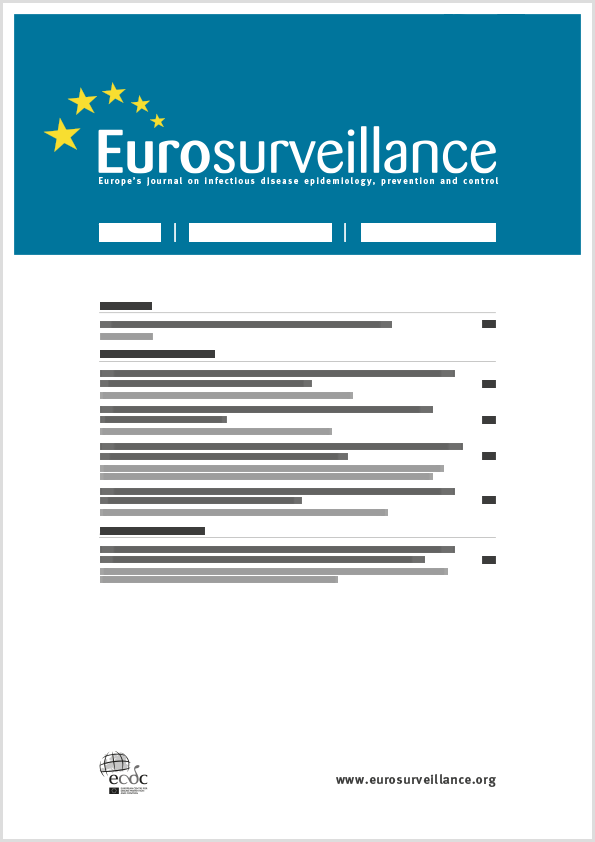- Home
- Eurosurveillance
- Previous Issues
- Volume 9, Issue 9, 01/Sep/2004
Eurosurveillance - Volume 9, Issue 9, 01 September 2004
Volume 9, Issue 9, 2004
- Outbreak report
-
-
-
Outbreak of Clostridium histolyticum infections in injecting drug users in England and Scotland
J S Brazier , M Gal , V Hall and T E MorrisMore LessClostridial infections in injecting drug users in the United Kingdom are a relatively new phenomenon that came to light in 2000 when cases of serious illness and deaths due to Clostridium novyi were recorded. In the period December 2003 to April 2004, the Anaerobe Reference Laboratory received twelve referrals of an extremely rare isolate, Clostridium histolyticum, from cases of infection in injecting drug users submitted from nine different hospitals in England and Scotland. Molecular typing of these isolates by two different methods of pulsed-field gel electrophoresis and PCR ribotyping revealed they are all indistinguishable, indicating a common source of the infections, most probably a batch of heroin that was recently distributed across the UK.
-
- Top
-
- Surveillance report
-
-
-
Travellers returning to Sweden as sentinels for comparative disease incidence in other European countries, campylobacter and giardia infection as examples
K Ekdahl and J GieseckeMore LessComparable figures on disease incidence between countries are difficult to attain. We therefore compared risk of infection for Swedes going to other European countries. We took as the numerator the number of imported cases from European countries of campylobacter and giardia infection in the national Swedish surveillance database, and as the denominator, the number of visitors to each country from a commercial database on foreign travel. Risk of infection in tourists was also compared to national incidence figures for a selection of countries.
-
-
-
Surveillance data on paediatric HIV infection and AIDS in Greece
G Nikolopoulos , V Konte , A Masgala , E Eleni , A Tsantes and D ParaskevaMore LessIn Greece, HIV/AIDS surveillance is conducted by the Hellenic Centre for Infectious Diseases Control. The AIDS case reporting system was implemented in 1984, followed by notification of HIV infections in 1998. This article presents surveillance and trend analysis of paediatric HIV infection and AIDS, including cases identified prior to 1998. The number of HIV infected children in Greece is relatively low, raising to a cumulative total of 69 cases by June 2003, 44 (64%) of whom are thought to have been infected through mother-to-child transmission. Thirty three paediatric AIDS cases have been reported since the onset of epidemic, with Pneumonocystis carinii pneumonia being the most frequent opportunistic infection.
-
-
Volumes & issues
-
Volume 30 (2025)
-
Volume 29 (2024)
-
Volume 28 (2023)
-
Volume 27 (2022)
-
Volume 26 (2021)
-
Volume 25 (2020)
-
Volume 24 (2019)
-
Volume 23 (2018)
-
Volume 22 (2017)
-
Volume 21 (2016)
-
Volume 20 (2015)
-
Volume 19 (2014)
-
Volume 18 (2013)
-
Volume 17 (2012)
-
Volume 16 (2011)
-
Volume 15 (2010)
-
Volume 14 (2009)
-
Volume 13 (2008)
-
Volume 12 (2007)
-
Volume 11 (2006)
-
Volume 10 (2005)
-
Volume 9 (2004)
-
Volume 8 (2003)
-
Volume 7 (2002)
-
Volume 6 (2001)
-
Volume 5 (2000)
-
Volume 4 (1999)
-
Volume 3 (1998)
-
Volume 2 (1997)
-
Volume 1 (1996)
-
Volume 0 (1995)
Most Read This Month

-
-
Detection of 2019 novel coronavirus (2019-nCoV) by real-time RT-PCR
Victor M Corman , Olfert Landt , Marco Kaiser , Richard Molenkamp , Adam Meijer , Daniel KW Chu , Tobias Bleicker , Sebastian Brünink , Julia Schneider , Marie Luisa Schmidt , Daphne GJC Mulders , Bart L Haagmans , Bas van der Veer , Sharon van den Brink , Lisa Wijsman , Gabriel Goderski , Jean-Louis Romette , Joanna Ellis , Maria Zambon , Malik Peiris , Herman Goossens , Chantal Reusken , Marion PG Koopmans and Christian Drosten
-
- More Less


